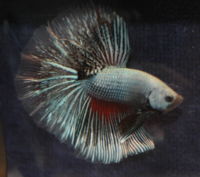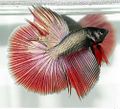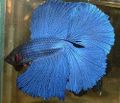Siamese Fighting Fish (Betta splendens)
From The Aquarium Wiki
(Redirected from Baita)
Siamese Fighting Fish
Betta splendens
8 Litres (2 US G.)
5.1-7.6cm (2-3 ")
Freshwater
6.0 - 7.8
23.9-27.8°C (75 -82 °F)
4-10 °d
1:0 M:F
2-7 years
Family
Osphronemidae
This animal is available captive bred
Contents
Additional names
- Betta, Beta, Siamese Fighting Fish, Chinese Fighting Fish, Japanese Fighting Fish, Mexican Fighting Fish
Origin[edit]
- Wild Betta splendens are green/brown with red fins in a plakat (short-tailed) shape. These wild types are found in wide rice paddies in Thailand, Cambodia, Vietnam and Malaysia. Although shallow (between 7.6-15.2cm (3-6") depending on season) these are very wide bodies of water, meaning the theory that Bettas live in puddles is completely untrue since even in the dry season the "puddles" are still connected into wide bodies of water.
Sexing[edit]
- Male Bettas are generally more colourful and have much larger fins than females. Females have short fins, and when viewed in aquarium shops or in a stressed condition they appear to lack colour. But once in a suitable tank and have settled in their colours will come through also.
- Females also have an ovipositor visible, a small white dot just behind their ventral fins, although young males frequently show a false "egg spot" as well. A female's ventral fins will also be shorter and thinner than a male's. In traditional Plakat (short-finned) types her anal fin will be rounded and more rectangular rather than finishing to a point, as a male's does.
- Both male and female fish will flare their gills and extend their fins, however the gills on a female will be smaller, whereas a male's gills when flared have a "beard" membrane which extends out like a ruff.
Breeding[edit]
- Breeding Bettas should not be taken lightly and should be planned carefully before a pair is prepared for breeding. It can take 2-3 weeks for a pair to be conditioned (with excellent water quality and plenty of live food) before they can be put together. Once the spawn has become free-swimming it takes almost 6 months to a year before they are ready to go to new homes, and each of these fish will need daily care and water changes to ensure optimum health.
- See our illustrated article, Breeding Betta splendens, for more details on how to breed these popular fish.
Tank compatibility[edit]
- Bettas are relatively peaceful fish. Their aggressive behaviour shows when mixed with other members of the Osphronemidae family or anything with long, colourful fins that the Betta may confuse for another Betta such as male Guppies.
- Males should not be kept with other males or females. Females develop a hierarchy so should be kept alone or in groups of 5 or more in a minimum of 76 Litres (20 US G.) with large amounts of plants to establish territories in. Males should only be kept with females during the brief breeding period.
- Bettas should not be kept with aggressive tank mates such as Cichlids or with fish that can nip their long fins such as Danios, Tetras or Barbs.
Diet[edit]
- Carnivore. In the wild, diet is insects and insect larvae. As aquarium pets, their main diet should consist of specially formulated Betta pellets with a minimum of plant ingredients (such as New Life Spectrum Betta). May be fed Brine shrimp, Daphnia, and bloodworm occasionally. Frozen foods in an appropriate balance may be fed as a main diet, but freeze-dried foods should be only an occasional treat. An occasional feeding of live food like mosquito larvae or flightless fruit flies is beneficial.
Feeding regime[edit]
- See also: General feeding regime for common fish
- Feed once or twice a day in small quantities. They appreciate a mixed diet and can prove fussy; they love live food, but care must be taken that they do not become so fussy to the point they will only accept live food.
- Bettas are also prone to constipation, so to prevent this keep portion sizes small, and in fish known to be delicate avoid overusing commercial dry fish foods like flakes, pellets, and freeze-dried foods which can swell with water in the fish’s gut. Soaking dry food prior to feeding will help reduce the risk of bloating. Frozen daphnia can also be added to a balanced diet and acts as a mild laxative.[1] Bettas can go up to a week without food providing they have been well fed beforehand.
Environment specifics[edit]
- While its technically true that Bettas can live in a small and unheated bowl, they are more likely to become sickly and lethargic. They will live longer and thrive in larger surroundings. Like other tropical fish, Bettas will thrive best in heated tanks, with live plants and plenty of room to swim. At least 8 Litres (2 US G.)is preferred. They are tropical fish and will therefore prefer to live in the higher temperature range of around 24.4-27.8°C (76-82°F) .
- The males do not always do well in strong currents, especially the long-finned varieties as they are not strong swimmers. For this reason, and because the frequent water changes necessary without a filter are too stressful for them, a sponge filter or a filter which has been modified to lessen the force of its current is recommended.
- Bettas are labyrinth breathers and therefore must have access to the surface at all times. A centimeter or so of space between the surface of the water and a solid lid is sufficient, as larger gaps reduce the amount of water available to them.
- Some Bettas will jump, so a lid is recommended on any betta tank. Some jumpers won't stop even if you put a cover over their tank. With persistent jumpers there needs to be a minimal amount of air space (1/2") between the water and tank hood to prevent injury.
- For centuries Far East Betta breeders have kept this fish with Indian Almond Leaves (Terminalia catappa), the tannins released by this leaf acts like bogwood, and give the fish essential chemicals, promotes beneficial fungi and bacteria etc. These leaves are on sale on eBay and at good Betta dealers.
Behaviour[edit]
- Bettas are curious creatures. They enjoy exploring every nook and cranny of their tanks. They appreciate live plants and caves to swim around and through. You may notice they will sit on, lean on, or "claim" an object. They are quite peaceful and will get along with most other fish which are not fin nippers or that look like them. Bettas will flare out the sides of their faces to warn other fish not to mess with them or if they see an object that they mistake for another Betta.
Common Diseases[edit]
- Bettas are prone to Fin Rot also known as Fin Melt. It is A bacterial infection that can happen due to poor water quality or a lot of stress, but the result is always the same: decaying fins and tissue that leads to your betta fish losing its beautiful colors. White milky edges are usually a good sign of fin rot. [2]
Identification[edit]
- Please see our article on Betta splendens variations to identify your sub breed
https://fishing-en.com/seine-fishing-nets-and-your-strong-devices/
Special notes[edit]
- Interestingly, the veil tail Betta is now hardly ever shown at fish shows, as it is considered by many Betta breeders as 'common' and not worth displaying any more.
- The Siamese Fighting Fish is actually a hybrid of true Betta splendens, Betta imbellis, and Betta smaragdina. Pure/wild-type Betta splendens are rare.
- Siamese Fighting Fish were deliberately selectively bred for territorialism/aggression. This is why true wild Betta splendens males are far less likely to fight each other when kept in groups in an appropriately-sized tank (minimum 10 gallons advisable when keeping either groups of wild males & females, or groups of the female domesticated Siamese Fighting Fish). This means that theoretically male Siamese Fighting Fish can be kept together provided the aquarium is large enough (approximately 20-30 gallons minimum for 2-4, if not [preferably] larger, especially if there's even more males than that) with plenty of hiding places, including copious amounts of plant cover.
- Several aquarists debate on whether the Betta should be kept in tanks or bowls since their natural environment consists of "small, shallow areas of water". However, their natural environment, while being shallow, is often acres wide. This does not mean a large tank is not suitable for a Betta, by all means a larger tank/bowl would be better for them.
- Bettas, like Gouramis, are a labyrinth fish, in that they have a special organ that allows them to breathe air at the surface in conjunction with regular gills, so they can survive in poorly oxygenated water. If they are not allowed access to the air in a poorly oxygenated aquarium then they may drown.
- As they age, a Betta's colouration often changes; those with the marble gene constantly change. There is also a red loss gene that means a Betta born with a lot of red in the fins will lose all red as it matures. The redloss gene is desirable in Betta shows.
- Longfinned Bettas, especially half moons and veil tails, can sometimes find themselves getting hampered down by their own tails, or through boredom, can turn to tail biting. Sometimes fish will do these because of a change in environment, as a result of fin rot, or you simply have a nervous fish with a vengeance against its own tail! There is no real known cure for this, but increasing the number of plants in the tank to reduce stress may help. If a betta won't stop, simply keep their water clean to prevent infection.
- If the fry do regular flaring exercise, the spread of their tail may increase resulting in a more desirable 180° spread in halfmoon types. Put a mirror in front of the tank or inside the tank, as soon as it sees its own reflection, it will become active and try to fight the reflection. Allow them to see this mirror for no more than half an hour, two or three times a week.
- Heavily finned variations such as the halfmoons may occasionally "blow" their tail or develop a split in their tail from flaring. This will heal eventually but must be watched for fungus or bacterial infections initially.
- Can be prone to finrot if kept at less than ideal temperatures or in dirty water. Try to keep them around 24.4-27.8°C (76-82°F) and perform weekly water changes.
- Not recommended to be housed with Dwarf African Frogs or other aquatic frogs. When the male Betta matures and becomes sexually active he will defend his territory from all intruders. The laid-back manner of these frogs also means that often the Betta eats their food first and gets fat, while the frogs often starve.
Pictures[edit]
For more images of Bettas click here.
Videos[edit]
| Dancing male platinum copper Betta with tail damage: | Female Betta: | International Betta Competition 2013: |
References[edit]
- ↑ Nippyfish.net Bettas and curing constipation.
- ↑ fishkeepingacademy.com What Causes Fin Rot In Bettas.
External links[edit]
- Fishbase (Mirrors:
 )
)





